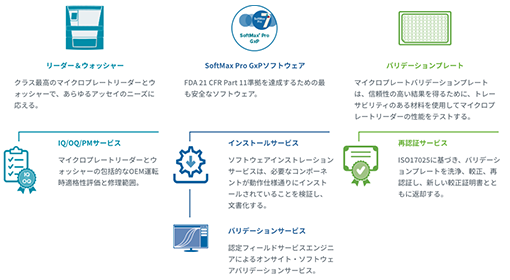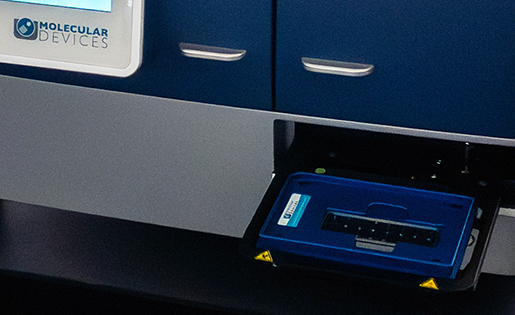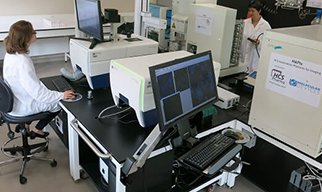細胞の損失を最小限に抑え、アッセイ性能を
最適化した効率的なセル洗浄
AquaMax®マイクロプレートウォッシャーは、96ウェルおよび384ウェルのマイクロプレート用に設定可能な、完全に自己完結型のシステムです。設定済みの洗浄、ソーク、吸引プロトコルを使用するか、シンプルなタッチスクリーンインターフェースを使用して独自のマルチステッププロトコルを作成します。生化学アッセイでは、ウォッシャーが未結合物質や未反応試薬を除去します。細胞ベースアッセイでは、96ウェルまたは384ウェル細胞洗浄用ヘッドのオプションがあり、角度のついたピンで接着力の弱い細胞も非常に穏やかに洗浄できます。
AquaMaxマイクロプレートウォッシャーの特長
-

設置が簡単
ウォッシャーは外部ポンプやコンピューターを必要としないため、ベンチスペースを最小限に抑えることができます。交換可能な洗浄ヘッドは、工具やキャリブレーション、アライメントなしで数秒で設置できます。
-

プレートの割り出しをなくす
96ウェルおよび384ウェルの吸引と分注がすべてのウェルで同時に行われるため、機械的なプレート割り出しやクワドラント処理が不要で、高精度のアッセイと迅速なマイクロプレート処理が可能になります。
-

複数の洗浄プロトコルを実行
色分けされたチューブを備えた2液または4液インレットにより、バッファーボトルと溶液ボトルの迅速な組み立てが可能になり、ボトルを交換することなく複数の洗浄プロトコルを実行できます。
-
汎用性
正確な分注と吸引コントロールにより、セルを破壊することなく処理できます。高速シーケンシャル、連続、ボトム洗浄オプションにより、洗浄時間を最小限に短縮します。
-
柔軟性
自動的に検出され、交換可能な96および384洗浄ヘッドを使用することにより、AquaMaxマイクロプレートウォッシャーは、現在および将来の高密度マイクロプレートアプリケーションの要件を満たすように簡単に構成できます。
-
自動化
この洗浄機は、最新の自動化ツールと簡単に統合できます。Molecular Devices社のStakMax®マイクロプレートスタッカーや多くのロボットプレートハンドラーと互換性があります。
-
実績あるGxPソリューションでデータインテグリティとコンプライアンスを保証
GMP/GLP規制環境下施設のための当社の包括的な一連の実績あるコンプライアンスソリューションは、みなさまの取り組みを促進し、迅速に自信を持って、規制に準拠した施設を確立します。
- ・最高クラスのマイクロプレートリーダーおよび ウォッシャーですべてのアッセイニーズをサポート
IQ/OQ/PMサービスにより、規制を遵守したデジタルフォーマットで機器の文書を保存 - ・ソフトウェアインストールサービスで、操作仕様のために必要な要素がインストールされていることを確認し記録
- ・ソフトウェアバリデーションサービスはFDA 21 CFR Part 11ガイドラインをサポート
- ・IT担当者の負担を軽減するWindows Active Directoryとの連携やバリデーションプレートなどのトレーサブルな材料を用いて、信頼性のある結果を得るために必要なマイクロプレートリーダーの性能を試験

- ・最高クラスのマイクロプレートリーダーおよび ウォッシャーですべてのアッセイニーズをサポート
-
「SpectraDrop 微量サンプル測定プレート」でより少量のDNA、RNA、タンパク質をより迅速に定量
卓上型マイクロプレートリーダーのためのマイクロボリュームソリューション SpectraDrop™微量サンプル測定プレートは少量測定のためのハイスループットソリューションを実現します。革新的なデザインにより、サンプル調製時間を短縮し、2 µLという少量のDNA、RNA、タンパク質サンプルに対するラボの生産性を高めることができ、吸光、蛍光測定モードに対応します。マイクロプレートのフォーマットは均一で再現性のある分析を保証し、Molecular Devices 製StakMax®マイクロプレートスタッカーとシームレスに統合することで研究能力を向上させることができます。
詳しくはこちら
AquaMaxマイクロプレートウォッシャーの仕様
| 一般仕様 | |
| 寸法(インチ) | 8.3(H)×18.3(W)×20.3(D) |
|---|---|
| 寸法(cm) | 21(H)×46.6(W)×51.7(D) |
| 電源 | 自動切替 |
| 重さ(設置) | 40.8 ポンド(18.5 kg) |
| 洗浄ヘッド | PET(ポリエチレンテレフタレート)、304 ステンレス鋼 |
| 接液部材質 | ナイロン、ポリプロピレン、テフロン、ポリエチレン、ステンレス、シリコン |
| 適合マイクロプレート | SBS適合の96ウェルおよび384ウェルのマイクロプレート;平底、U底、V底プレート |
| 液体インレット | 2または4 |
| インターフェース接続 | USBおよび特許取得済みStakMaxコネクト |
| 排出口 | 排水または封じ込め容器への排液 |
| シェイクオプション | 3スピード |
| 規制認証 | cTUVusマーク |
| 性能仕様 | |
| 精度(96ウェル) | < 4% CV @ 300 µL |
| 精度(384ウェル) | ≤ 3% CV @ 100 µL |
| 洗浄時間 96洗浄ヘッド,300 µL/ウェル | シングルサイクル:11秒 3サイクル:26秒 |
| 洗浄時間 384洗浄ヘッド、100 µL/ウェル | シングルサイクル:12秒 3サイクル:28秒 |
| FastWash時間(スピードに最適化) | 96ウォッシュヘッド、300 µL/ウェル、3サイクル: 14秒 384ウォッシュヘッド、100 µL/ウェル、3サイクル:16秒 |
| StakMax®マイクロプレートハンドリングシステム(高速ウォッシュ、96ウォッシュヘッド、300 µL/ウェル、3サイクル) | < 13 min. for 20 plates |
| 洗浄量 | 100-3000 µL |
| 残量,96 | ≤ 5 µLD |
| 残量,384 | ≤ 2 µL |
| 分注量 | 10~400μL/ウェル |
詳細を見る
-
試薬・消耗品・アクセサリー
該当の試薬・消耗品はありません。
-
保守サービス・サポート
